16 February, 2002
PHYTOPLANKTON !
Phytoplankton are plants (algae) of the ocean. They come in
many sizes, colors, and species. You need to look through a microscope to
see these individual plant cells. However, during the growing season, there
are "blooms" of phytoplankton. Then it is possible to see large amounts of
phytoplankton in the water. Phytoplankton, like other plants, need energy
from sunlight in order to grow. They use sunlight and their own chlorophyll
to turn the minerals in the water into "food" and growth.
Phytoplankton are important parts of the food web. Small animals in the
ocean (zooplankton) eat phytoplankton. In turn, the zooplankton are eaten
by larger animals. So, it is very important to know about the phytoplankton
growing in the Palmer LTER region. (For more information about this food
web, visit the Polar Science Station at
http://literacynet.org/polar/pop/html/project-ecosystem.html)
The Palmer LTER phytoplankton group is lead by Dr. Maria Vernet. This group
studies phytoplankton in the waters of the Southern Ocean. The group also
studies the phytoplankton in the waters close to Palmer Station.
These scientists want to know what kinds of phytoplankton are growing here,
and how fast they are growing. To do this, scientists study "the water
column". Picture an imaginary tube or column of water that goes from the
surface down to the ocean floor. If you could take pieces of that column
from the surface to the bottom, you could have an idea of what is growing in
the water there.
That is exactly what the phytoplankton group does! The group members go out
twice a week in the Zodiac called "Bruiser". The scientists want to take
water samples at places in the water column where the light is 100% (of the
surface light), 50%, 25 %, 10 % , 5%, and 1%. The depths of those light
levels will change, depending on what is in the water. (If there is a lot
of thick phytoplankton near the water surface, that patch of plankton will
block out any sunlight in the water below them)
The group first puts a PRR (Profiling Reflectance Radiometer) in the water.
This measures the levels of light at various depths in the water column. The
information is sent back to a laptop computer on the Zodiac. For example,
the 1% light level could be 75 meters deep in the water column. Or, because
of phytoplankton bloom, the 1% light level could be very shallow, as it is
now. That level now is only 13 meters deep.
Then the team members know where to get their water for that day! They put
a line over the side with a Go-Flow bottle on it. They send a "messenger"
down the line to close the Go-Flow bottle when it is at the proper depth.
They bring up 4 liters of water from each light level. This water sample
goes into a container on the Zodiac. The container of water is put into a
cooler. The scientists also tow a net for other samples. They do this at
stations B and E on the Palmer LTER map grid.
Then the scientists bring the water samples back to Palmer Station. They
study the plants in this water in many ways. The scientists pour some of
the water through filters. Then they use a microscope to look at the plant
cells that remain on the filters. The scientists use another process to
measure the color pigments in the cells. Finally, they set up some
experiments to study the growth of plant cells at different light levels.
That's the way scientists learn about these important plants in the
ocean!!

Bruiser and her scientists are collecting water samples at Station E.
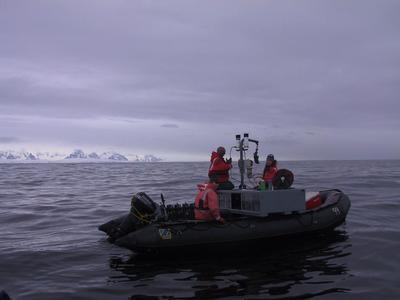
Lisa Ferber, Karie Sines, and Karen Pelletreau are collecting water samples at Station E.
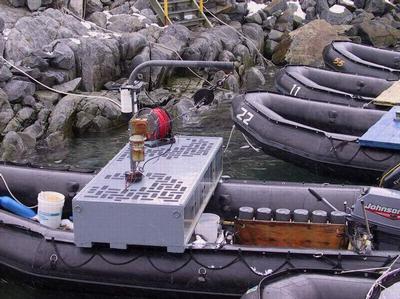
Bruiser is loaded with equipment and waiting for scientists.

Zodiac #99 is "Bruiser". It is used by the phytoplankton scientists to collect their water sample. Zodiac #44 is "Low Rider", used by the krill hunters. (see journal 02/17/02)

Lisa Ferber and Jordan Watson prepare the equipment before departure.

Maria demonstrates one process by which a water sample is filtered. The plant cells in that water sample are prepared for viewing under a microscope.

Dr. Maria Vernet, leader of the phytoplankton group for the Palmer LTER.
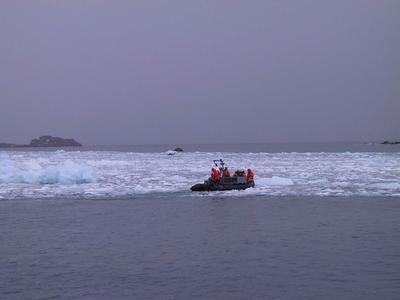
The krill hunters are out in one Zodiac. The phytoplankton group is in the foreground. The groups go out on the same day to take measurements in the same places. This is how the Palmer LTER collects data.
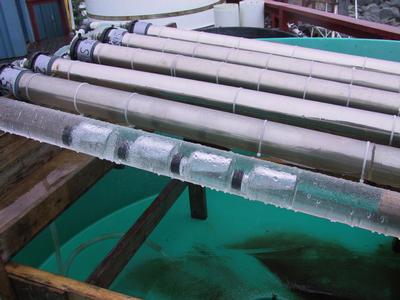
In this view, you can see four bottles within this tube filled with running sea water. The bottles contain phytoplankton in water samples taken earlier in the day. There are two bottles of water samples from each of six light depths at a station. (This one is from the 100% light, so the tube is clear) The phytoplankton scientists go to two stations each time they go out to collect samples. They let the plankton grow in this experiment for 24 hours, and then the phytoplankton growth is measured. Here's the math: how many small bottles of water are contained in this experiment?

Maria Vernet demonstrates the incubation tubes outside the aquarium. Phytokplanton are growing inside these tubes of running seawater.

Here is a close-up view of the six tubes. The tube on the left is clear. It hass no screening. It represents the 100% light level. You can see the screening around the tubes to the right.
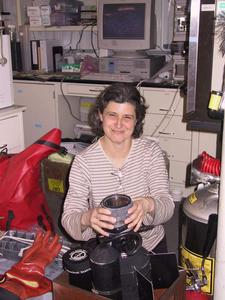
Maria Vernet shows us the PRR. This instrument is put into the water to determine the light levels. This is the way that the team knows where to take the water samples they need.

There are six tubes here, with sea water running through them. Each long tube represents one of the six light levels: 100%, 50%, 25%, 10%, 5%, and 1%. The tubes which represent the lower light levels have layers of screening around them. This regulates the amount of light that gets through to the phytoplankton samples inside the tube.

Karen Pelletreau (center) works on one of the Go-Flow water collecting containers. Tim Brox (left), Jordan Watson, and Lisa Ferber look on.

Sometimes there is a lot of ice to go through. We go very slowly, so that there isn't any damage to the Zodiac.

This map gives you an idea of the relationship between Palmer Station, the islands, and Stations A-I on the Palmer sampling map. The phytoplankton group takes water samples at stations B and E. They also tow nets in this area as well. The nets are used to collect phytoplankton.

When it is high tide, it is sometimes challenging to back the Zodiac out. It is important to move the stern guide lines so that the davit and winch can pass underneath.
Contact the TEA in the field at
.
If you cannot connect through your browser, copy the
TEA's e-mail address in the "To:" line of
your favorite e-mail package.
|
